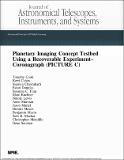Planetary Imaging Concept Testbed Using a Recoverable Experiment–Coronagraph (PICTURE C)
Author(s)
Cook, Timothy; Cahoy, Kerri; Chakrabarti, Supriya; Douglas, Ewan; Finn, Susanna C.; Kuchner, Marc; Lewis, Nikole; Marinan, Anne; Martel, Jason; Mawet, Dimitri; Mazin, Benjamin; Meeker, Seth R.; Mendillo, Christopher; Serabyn, Gene; Stuchlik, David; Swain, Mark; ... Show more Show less
DownloadCahoy_Planetary imaging.pdf (952.6Kb)
PUBLISHER_POLICY
Publisher Policy
Article is made available in accordance with the publisher's policy and may be subject to US copyright law. Please refer to the publisher's site for terms of use.
Terms of use
Metadata
Show full item recordAbstract
An exoplanet mission based on a high-altitude balloon is a next logical step in humanity’s quest to explore Earthlike planets in Earthlike orbits orbiting Sunlike stars. The mission described here is capable of spectrally imaging debris disks and exozodiacal light around a number of stars spanning a range of infrared excesses, stellar types, and ages. The mission is designed to characterize the background near those stars, to study the disks themselves, and to look for planets in those systems. The background light scattered and emitted from the disk is a key uncertainty in the mission design of any exoplanet direct imaging mission, thus, its characterization is critically important for future imaging of exoplanets.
Date issued
2015-09Department
Massachusetts Institute of Technology. Department of Aeronautics and AstronauticsJournal
Journal of Astronomical Telescopes, Instruments, and Systems
Publisher
SPIE
Citation
Cook, Timothy et al. “Planetary Imaging Concept Testbed Using a Recoverable Experiment–Coronagraph (PICTURE C).” Journal of Astronomical Telescopes, Instruments, and Systems 1.4 (2015): 44001.
Version: Final published version
ISSN
2329-4124
2329-4221